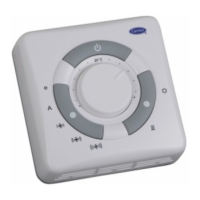PG80VTLA: Installation, Start-up, Operating and Service and Maintenance Instructions
Manufacturer reserves the right to change, at any time, specifications and designs without notice and without obligations.
25
ACCESSORIES
1. Electronic Air Cleaner (EAC)
Connect an accessory Electronic Air Cleaner (if used) using 1/4-in
female quick connect terminals to the two male 1/4-in
quick-connect terminals on the control board marked EAC-1 and
EAC-2. The terminals are rated for 115VAC, 1.0 amps maximum
and are energized during blower motor operation. (See Fig. 36).
2. Humidifier (HUM)
Connect an accessory 24 VAC, 0.5 amp. maximum humidifier
(if used) to the 1/4-in male quick-connect HUM terminal and
COM-24V screw terminal on the control board thermostat strip.
The HUM terminal is energized when blower is energized in
heating. (See Fig. 36).
NOTE: DO NOT connect furnace control HUM terminal to HUM
(humidifier) terminal on Thermidistat, Zone Controller or similar device.
See Thermidistat
©
, Zone Controller, thermostat, or controller
manufacturer’s instructions for proper connection.
A190044
Fig. 36 – Variable Speed Furnace Control for ECM Blower Motor
VENTING
The furnace shall be connected to a listed factory built chimney or vent,
or a clay-tile lined masonry or concrete chimney. Venting into an unlined
masonry chimney or concrete chimney is prohibited.
When an existing Category I furnace is removed or replaced, the original
venting system, may no longer be sized to properly vent the attached
appliances. An improperly sized Category I venting system could cause
the formation of condensate in the furnace and vent, leakage of
condensate and combustion products, and spillage of combustion
products into the living space.
Vent system or vent connectors may need to be resized. Vent systems or
vent connectors must be sized to approach minimum size as determined
using appropriate table found in the current edition of NFGC.
GENERAL VENTING REQUIREMENTS
Follow all safety codes for proper vent sizing and installation
requirements, including local building codes, the National Fuel Gas
Code NFPA 54/ANSI Z223.1 (NFGC), Parts 12 and 13 in the United
States, the local building codes, and furnace and vent manufacturers’
instructions.
These furnaces are design-certified as Category I furnaces in accordance
with ANSI Z21.47/CSA 2.3 and operate with a non-positive vent static
pressure to minimize the potential for vent gas leakage. Category I
furnaces operate with a flue loss not less than 17% to minimize the
potential for condensation in the venting system. These furnaces are
approved for common venting and multi-story venting with other fan
assisted or draft hood equipped appliances in accordance with the
NFCG, local building codes, and furnace and vent manufacturers’
instructions.
The following information and warning must be considered in addition
to the requirements defined in the NFGC.
1. If a vent (common or dedicated) becomes blocked, the furnace will
be shut off by the draft safeguard switch located on the vent elbow.
2. Two-stage furnaces require Type B vent connectors outside the
casing in all configurations. Single wall vent connector may be
used inside the furnace casing with the transition to Type B vent
outside the furnace casing. Size the connector so that the FAN-Min
24-V THERMOSTAT
TERMINALS
PL2 – (115VAC) HOT SURFACE
IGNITER SIGNAL & INDUCER
MOTOR CONNECTOR
115-VAC (L2) NEUTRAL
CONNECTIONS
115-VAC (L1) LINE
VOLTAGE CONNECTIONS
EAC-1 TERMINAL
115-VAC 1.0 AMP MAX.
PL1 – LOW
VOLTAGE MAIN
HARNESS
CONNECTOR
TRANSFORMER 24-VAC
CONNECTIONS
3-AMP FUSE
STATUS AND COMM
LED LIGHTS
SW1 SETUP
SWITCHES AND
BLOWER OFF-
DELAY
MODEL PLUG
CONNECTOR
SW2 AIR CONDITIONING
(AC) AIRFLOW SETUP
SWITCHES (6, 7, 8)
COMMUNICATION
CONNECTOR
(WHEN USED)
SW2 CONTINUOUS FAN (CF)
AIRFLOW SETUP SWITCHES (3, 4, 5)
HUMIDIFIER
TERMINAL (24-VAC
0.5 AMP MAX.
ACRDJ – AIR
CONDITIONING
RELAY DISABLE
JUMPER
FLASH
UPGRADE
CONNECTOR
(FACTORY
ONLY)
SOFTWARE
VERSION (V##)
BOARD PART
NUMBER LOCATION
WARNING
!
CARBON MONOXIDE POISONING HAZARD
Failure to follow this warning could result in personal injury or death.
Do not bypass the draft safeguard switch, as an unsafe condition could
exist which must be corrected.

